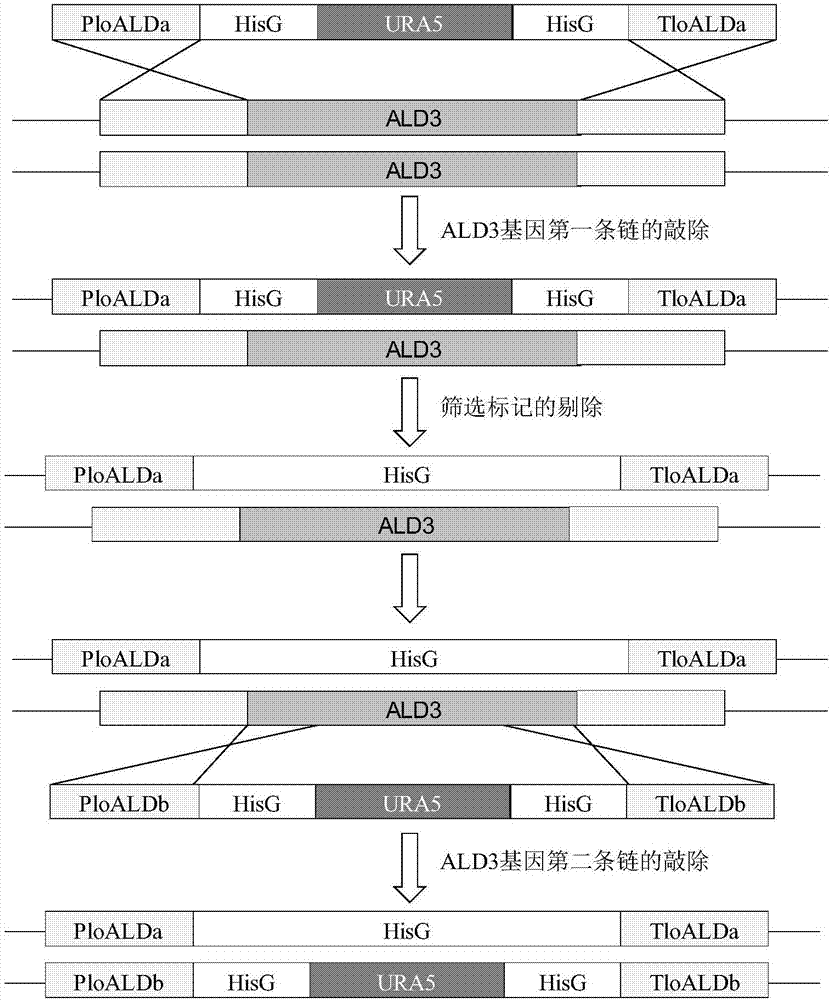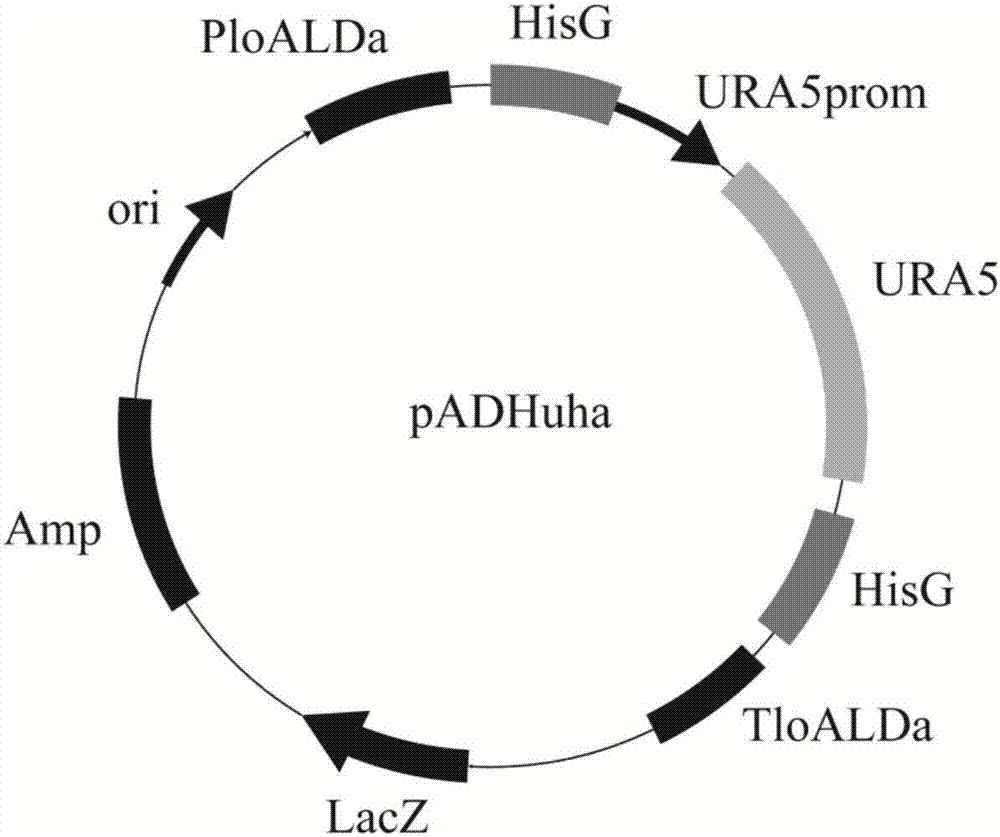Preparation method and application of high-yield 2-phenylethanol with candida glycerinogenes engineering bacterium
A Candida and phenylethanol technology, applied in the field of genetic engineering, can solve the problems of difficult product purification, large loss, toxicity hindering the production of 2-phenylethanol, etc., and achieve the effect of overcoming the toxic effect and increasing the yield
- Summary
- Abstract
- Description
- Claims
- Application Information
AI Technical Summary
Problems solved by technology
Method used
Image
Examples
Embodiment 1
[0021] Construction of heterozygous mutants with single-copy knockout of ALD gene
[0022] (1) Synthesis of knockout fragments
[0023] A 2.5kb ALD3 gene fragment was amplified by PCR, which included the nucleic acid sequence of 500bp-0bp upstream of ALD3 gene (PloALDa, SEQ ID No. 2), the nucleic acid sequence of 0p-500bp downstream of ALD3 gene and ALD3 gene (TloALDa, SEQ ID No. 2) .3). And connect with pMD19-T simple to obtain recombinant plasmid 19T-ALDa. Then, using 19T-Ald3a as a template, reverse PCR was used to obtain a PloALDa-19T-TloALDa fragment containing two homology arms, and the fragment of the selection marker HisG-URA5-HisG (HUH) was ligated through the restriction site to obtain the knockout plasmid 19T-PloALDa -HUH-TloALDa, named plasmid pADHuha, and the plasmid pADHuha was cut with restriction endonuclease BamH I to obtain a linearized knockout fragment
[0024] (2) Knockout of the first chain of ALD3 gene
[0025] Pick a ring of Candida glycerol-produci...
Embodiment 2
[0029] Construction of homozygous mutants with double-copy knockout of ALD3 gene
[0030] (1) Synthesis of knockout fragments
[0031] A 1.5kb ALD3 gene fragment was amplified by PCR and ligated with pMD19-T simple to obtain the recombinant plasmid 19T-ALD3b. Then, using 19T-Ald3b as a template, reverse PCR was used to obtain a PloALDb-19T-TloALDb fragment containing two homology arms, which was ligated with the screening marker HisG-URA5-HisG (HUH) fragment through the restriction enzyme site to obtain the knockout plasmid 19T-PloALDb -HUH-TloALDb, named plasmid pADHuhb, and the plasmid pADHuhb was cut with restriction endonuclease BamH I to obtain a linearized knockout fragment.
[0032] (2) Knockout of the second chain of ALD3 gene
[0033] A heterozygous mutant strain with a single-copy knockout of the ALD3 gene was picked and inoculated in liquid YPD medium and cultured at 30°C overnight. Take 100ul of the overnight culture medium and transfer it to fresh YPD, and incu...
Embodiment 3
[0035] Pick 1 ring of original Candida glyceride and ALD3 gene double-copy knockout homozygous mutant strains and insert them into the seed medium (yeast powder 10g / L, peptone 20g / L, glucose 20g / L, the balance is water ), under the conditions of 30 ° C, 200 r / min, shaking culture for 18 h, to obtain liquid seeds. The obtained liquid seeds are inserted into the inoculum containing 30mL fermentation medium (L-phenylalanine 7g / L, glucose 90g / L, KH 2 PO 4 5g / L, yeast powder 1g / L, MgSO 4 ·7H 2(00.5g / L, the balance is water) in a 250mL conical flask, the fermentation temperature is controlled to be 30°C, the rotational speed is 200r / min, the time is 72h, and the fermentation is completed.
[0036] The determination method of 2-phenylethanol in the fermentation broth is analyzed by high performance liquid chromatography (HPLC), and the details are as follows: the fermentation broth is centrifuged at 10,000 r / min, and then filtered with a 0.45 μm microporous membrane after centrif...
PUM
 Login to View More
Login to View More Abstract
Description
Claims
Application Information
 Login to View More
Login to View More - R&D
- Intellectual Property
- Life Sciences
- Materials
- Tech Scout
- Unparalleled Data Quality
- Higher Quality Content
- 60% Fewer Hallucinations
Browse by: Latest US Patents, China's latest patents, Technical Efficacy Thesaurus, Application Domain, Technology Topic, Popular Technical Reports.
© 2025 PatSnap. All rights reserved.Legal|Privacy policy|Modern Slavery Act Transparency Statement|Sitemap|About US| Contact US: help@patsnap.com



